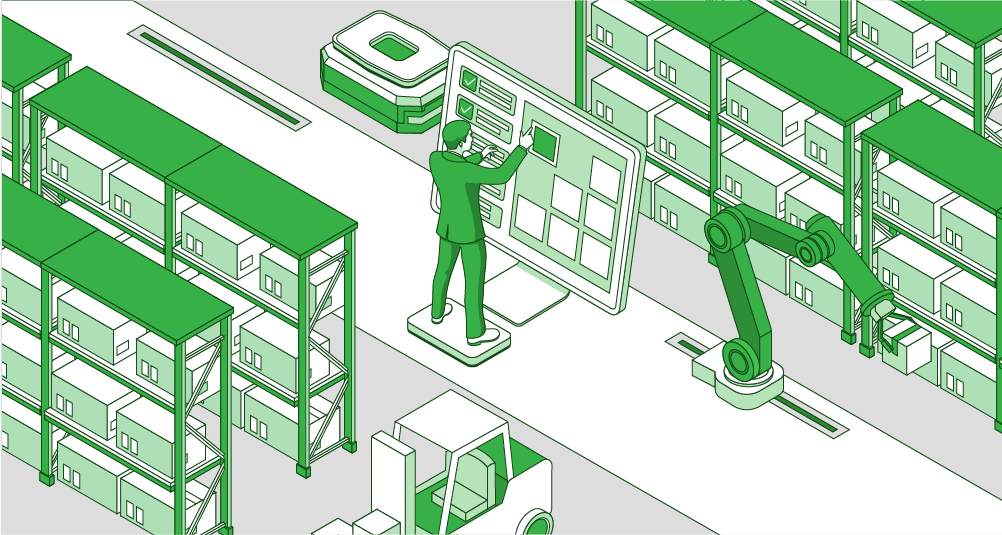Looking through all the business activities that keep your business up and running, we should consider the WMS system. The warehouse management system should include features that will drive your company to the first league among companies that serve distribution, warehouse, contract logistics, and fulfillment.
Logistics and warehouse managers are aware of the value that a WMS offers. However, these systems require many considerations about the most efficient one that can provide the right functions required by the company. These considerations are even more important when you think that companies around the world spend about $350 billion a year on warehousing. This figure is growing every year as picking sizes shrink and costs rise, which is evident within omnichannel delivery. This results in increasing pressure not only on margins but also on service levels.
How warehouse management systems can help?
Warehouse system management, mostly retransform warehouse designs that help companies improve efficiency by 20 to 25 percent. This figure comes from solutions such as test-and-learn from digital twins. All that boils down to is that the WMS system is one of the parts of digital transformation. Today technology offers much more in this area.

Here are elements where warehouse management system features can help your business:
Automation of manual processes for warehouse operations
The warehouse management system features streamlined tasks from inventory management and warehouse management, such as receiving, picking, packing, and shipping, among others. It completely automates the most repetitive tasks. Very often, people can get error-prone tasks and integrate material handling equipment, such as mobile devices, to increase speed. This also helps with improving safety and efficiency.
Increase employee productivity
Along with warehouse management system features and their automation comes higher productivity. This is another area where the warehouse management system has its input in order to increase the accuracy of tasks. It helps you hire and retain employees because people like to work when work is easy. This is a simple statement but truly important, especially when you hire less computer-savvy personnel. Automation reduces the need for employees, allowing redeployment and additional training, increasing productivity and customer service.

Optimize warehouse operations and inventory management
Maintaining insight into inventory levels with a warehouse and inventory management system reduces maintenance costs and also costs associated with volumes. Maintenance operations can help you shrink warehouse space, which is required if your business is based on contract logistics, where you can have several customers in one warehouse. The system gives you insights into demand and goods flow, so you can optimize inventory data.
Deployment of best practices
With WMS, you can access so-called supply chain best practices to increase efficiency. Systems enable you to learn methods to deploy facilities, use technology, and manage your workforce to meet customer needs and control costs. This is a highly competitive advantage when it comes to customer acquisition. Most of the customers are aware of the value of the warehouse management system features and understand what it brings to the business: processes are harmonized and easy to track by transparency and well data management with document management.
Measure performance in multiple warehouses
WMS dashboards to track labor productivity, get better labor management and fulfillment speed and shipping accuracy are essential for KPIs. Identifying inefficiencies and cost issues to make informed decisions for continuous improvement and cost reduction is the main goal in every logistics industry.
Need help with warehouse management system development?
Learn how we can boost your logistics processes
Explore moreExperience in warehouse management systems operations
Looking at my experience in the logistics industry, working for companies such as UPS SCS in the Netherlands, I can truly say that KPIs in place are crucial. At the time I was responsible for the Control Tower and 14 collection points in the EMEA region (so, that ware operations exceeded over 14 countries). We took data from ERP systems to track online shipments and failures. Frankly speaking, we didn’t have a WMS system at the time. All data was fetched manually by me from various sources and added to Excel sheets.
In fact, I was forced to automate with MS Excel different reports to calculate better variables in daily performance. It was very time-consuming, but even with that, by using Macro and VBA, I was able to make a sanity check report weekly within 4 hours. It was very high performance but WMS could save much more time and energy. It could eliminate manual errors that often come in operation and I simply replicated them in my business analysis reports. So, a WMS system is just something that really changes the balance.
Taking experience from the logistics software development house, I also learned that the application of warehouse management software isn’t an easy task to implement. You need a company that really understands your business's unique needs in logistics and supply chain.
So, if you want a WMS system, we highly advise not taking an off-the-shelf solution. It will not fit your business as you wish. I saw several failures where companies after WMS implementation were still forced to calculate required data based on Excel spreadsheets. This shows that custom development of warehouse management software, like in the case of Adexin with proving transportation and truck application to the truck drivers, is the most suitable. This is because in this case it fits business needs the best, and Adexin understands logistics.

Advanced warehouse management systems features
The WMS system includes many features. By understanding business in logistics, and having direct experience in the business, we outlined 10 features that change business. Here you can see which operation the WMS system is integrating. So, in fact, it goes far beyond inventory management.
1. Inventory management
Receiving: Recording incoming goods using mobile scanners integrated with the Warehouse Management System (WMS) application.
Putting away: Assigning incoming goods to inventory locations throughout the warehouse using WMS-based mobile devices.
Replenishment: Moving goods from higher to lower racks and managing aging inventory using WMS-based mobile applications.
Order picking: Using WMS-based mobile devices to plan picking paths and streamline order picking, batching Picks, and Tasks.
Packing and labeling: Integrate printing devices with WMS and mobile devices for efficient packing and shipping labels.
Voice picking: Implement a voice system integrated with WMS and ERP for hands-free order picking.
Value-added services (VAS): Equipping VAS packing lines with handheld scanners and WMS-based desktop applications for material tracking.
Yard and Dock Management: Managing yard and dock operations with WMS to streamline the movement of trailers, optimize dock door assignments, and enhance loading/unloading efficiency.
Shipping: Managing outbound shipments with WMS-based mobile applications for accurate processing and fast loading.
Barcode Scanning and RFID Integration: WMS improves inventory management accuracy and efficiency by integrating barcode scanning and RFID technology. It enables real-time tracking and identification of goods throughout the supply chain.
Internal Transactions: Using warehouse management software on desktop and mobile apps to control inventory, manage allocations/relocations, and support inventory aging management.
Cycle Counting: Performing periodic inventory counts with WMS mobile applications on mobile devices.
Intercompany Transactions: Facilitating transactions between different entities within the same company using WMS to ensure seamless transfer of goods.
Staging & Storing: WMS supports pallet storage systems, rack labeling, and merchandise classification with WMS software for immediate goods allocation. Inventory aisles generator in cases of creating stock locations for custom clearance.
Real-Time Scheduling: WMS can utilize its capabilities to schedule tasks and allocate resources dynamically. It ensures efficient and timely execution of warehouse operations.
Inventory Control: Resolving inventory discrepancies promptly with WMS-based mobile applications.
Dangerous Goods Management: Alerting users via WMS when dealing with dangerous goods requiring proper storage, such as refrigeration or isolated high-security areas.
Fast-Moving Consumer Goods (FMCG): Managing temperature-sensitive goods and those with special storage requirements using the WMS.

2. Supply chain management
Traceability: Using a WMS to track inventory movement from receiving to shipping. It can also provide visibility and compliance across various locations, thus affecting supply chain capabilities.
Carrier management: Integrate carrier functions with the WMS to streamline transportation coordination in the supply chain. It includes carrier selection, scheduling, and performance monitoring from the WMS interface.

3. Transport management feature
Dock Planning: Strategically organize and manage the allocation of dock space in a warehouse to optimize the flow of goods during loading and unloading operations.
Loading Planning: Efficiently plan the loading of goods onto vehicles. WMS is taking into account factors such as vehicle capacity, load verification, product types, and delivery schedules to maximize transportation efficiency.
Integration with TMS: Seamlessly integrate with transportation management systems (TMS) to coordinate transportation activities. It can include route planning, carrier selection, and additional operations that are required during the transport, like loading extra goods from other warehouses. It ensures smooth and efficient transportation operations.

4. Order management
Order processing: Using a warehouse management system (WMS) to efficiently manage and process customer orders from receipt to shipment. Companies can connect to eCommerce systems, like online stores, and automatically receive orders. This ensures accuracy and timeliness.
Task monitoring system: Implement a system within the warehouse management system that assigns tasks to warehouse workers based on priority and location. All fully automate and monitor their progress in real-time to optimize workflow efficiency.

5. Reports and analysis
KPI Reports: Generate key performance indicators (KPI) reports within the warehouse management system (WMS) to track and analyze operational metrics. It enables data-driven decision-making and performance optimization. This is very important for warehouse managers.
Artificial intelligence integration for forecasting: Integrate artificial intelligence (AI) functions into the warehouse management systems to improve demand forecasting accuracy. In fact, it enables more accurate inventory planning and warehouse operations based on predictive analytics.

6. Financial management
Automated invoicing: Instead of manual invoicing hassles, streamline the process with automated invoicing built right into your warehouse management system (WMS). This lets you automatically generate invoices based on completed transactions, saving you time and ensuring accuracy.
Stock costs calculations: Get a clear picture of your inventory costs with the help of your WMS. By tracking inventory movements like purchases, sales, and adjustments, the system can accurately calculate your inventory costs and cost of goods sold. This valuable information helps you make informed business decisions.

7. Document management
Digital POD (Proof of Delivery): Implementing digital proof of delivery within the Warehouse Management System (WMS) to capture and manage delivery. This electronic warehouse management systems feature improves visibility into your delivery process by providing instant confirmation of successful deliveries.
Digital Document Workflows: No more drowning in paperwork in your warehouse. By utilizing digital document workflow automation within your WMS, you can automate the generation, approval, and distribution of documents.
Digital Picking Lists: Picking orders can be a time-consuming task, but not anymore. With digital picking lists generated within your WMS, your warehouse staff receives clear electronic instructions directly on their devices. Generating digital picking lists within the warehouse management systems to facilitate order picking operations, providing warehouse staff with electronic instructions for item retrieval, location details, and quantity verification.
Digital Contract Management: Managing contracts digitally within the WMS to centralize contract documentation, and automate contract creation and approval workflows (through digital signature).

8. Legacy systems and ERP integrations
ERP Integrations: Integrate a warehouse management system (WMS) with enterprise resource planning (ERP) systems to synchronize data and streamline business processes. It ensures seamless communication and data consistency across the organization.
Legacy Systems: Modernize and integrate legacy systems with WMS to ensure compatibility and business continuity. It provides a smooth transition from legacy systems to new technology while preserving valuable historical data and processes.

9. Carrier management
Implement loading time window scheduling in a warehouse management system (WMS) to optimize loading operations by assigning specific time slots to loading activities. Such scheduling ensures efficient use of resources, minimizes waiting times, and increases overall warehouse productivity.

10. Location management
Location Map: With the location map feature built into the WMS, this is a thing of the past! This digital map visualizes the entire warehouse layout, including storage locations, aisles, and zones. It can also help you view all of your company's connected warehouses.
Multiple warehouses Integration: Imagine your WMS working seamlessly with other systems managing your facilities in multiple warehouses. By integrating your WMS with tools such as building automation or maintenance management systems, you can unlock new levels of efficiency.

What to consider when choosing a warehouse management systems?
More than the basics: The power of integration. While connecting your existing software is important, consider these additional integrations: Marketplaces and Shipping Partners - streamline your sales by connecting to online shopping platforms and your favorite shipping providers; Multiple Stores and Warehouses - seamlessly manage your entire network of stores and warehouses with a single system.
Mobile matters: User-friendly on the go. A WMS should be accessible and easy to use on any device, whether it's a tablet or smartphone. Imagine managing inventory from the warehouse or checking order status on the go!
Customized to you: Customization options. The ideal WMS should adapt to your unique needs. Look for software that allows personalization so you can get the most out of it.
Grows with you: Flexibility and scalability. As your business grows, so should your WMS. Choose a solution that can scale to meet growing demands and changing needs.
Learning Curve: User interface and training. A user-friendly interface (UI) makes it easier for the team to quickly master the system. When evaluating different options, consider how much training will be required.
Beyond storage: Multifunctionality. Look for a WMS that goes beyond simple inventory management. Check out options that can also handle shipping, labor management, finance, and reporting, providing a complete operational picture.

What are the benefits of a warehouse management system?
Real-time paperless inventory: Barcodes and RFID offer real-time inventory tracking for organization and control.
Smooth supply chain: Seamless supply chain connectivity and data exchange automation to streamline inbound and outbound flows.
Happy Customers, Happy Business: Provide customers with real-time order updates and transparency through online tools.
Vendor Compliance Made Easy: Automatically generate compliant product labels, ensuring a seamless relationship with suppliers.
Optimized Logistics: Streamline manifesting, transportation planning, and routing to ensure on-time deliveries and satisfied customers.
Seamless order processing: Integrate with ERP for flawless order fulfillment, increasing productivity.
Production harmony: Synchronize warehouse operations with production to ensure efficient and coordinated production.
Highest accuracy and efficiency: Say goodbye to paper! Barcodes and RFID with minimal manual entry by entering SKU, or LOT numbers via keypads at computer stations in warehouses minimizing errors and streamlining overall operations.
Reduce costs, and increase profits: Streamlined supply chains and automated data exchange reduce costs associated with manual labor and labor management, remove errors and delays, increasing profits.
Smarter decisions, better results: Real-time data and analytics enable smarter choices. Optimize resource allocation, inventory planning, and operations for ultimate success.
Easy compliance, less risk: Automatically generate compliant labels and ensure seamless collaboration with suppliers. This minimizes compliance risks and promotes sustainability.
Enhanced security measures: Implementing a WMS strengthens security protocols by tracking inventory movements in real-time, reducing the risk of theft or loss at the facility.
Increased productivity: Leveraging WMS data analytics allows for better resource allocation and labor management.
Increased visibility and transparency: WMS platforms provide comprehensive visibility into inventory levels, order statuses, and shipment tracking.
Scalability and flexibility: As companies grow and evolve, WMS platforms offer scalability to accommodate increased inventory and changing operational needs.
Are you in search of a reliable tech partner?
Adexin can help with advanced logistics solutions
Contact usFinal takeaway on warehouse management system
Most digital transformation is failing because companies that create strategy don’t fully cover its implementation. At Adexin, we help you create an entire landscape and strategy, and further, we move toward your business transformation. So, you get the most suitable solution guided and implemented by a single company. This is what is called end-to-end secured digital transformation. We do the same with WMS system implementation. Warehouse managers may not need all the features, so we’ll focus on what matters for your operations most. You save costs and time. That's how simple it is.
Stay in touch with us. Briefly, we’ll provide downloadable content about the WMS system that you can keep in your records for further review. We also refer you to our guide to choosing a development partner, which will simplify your process. Do you want to know more? Don’t hesitate to contact us. We’re an organization that approaches each query with high attention to detail and the individual problems of the client.


